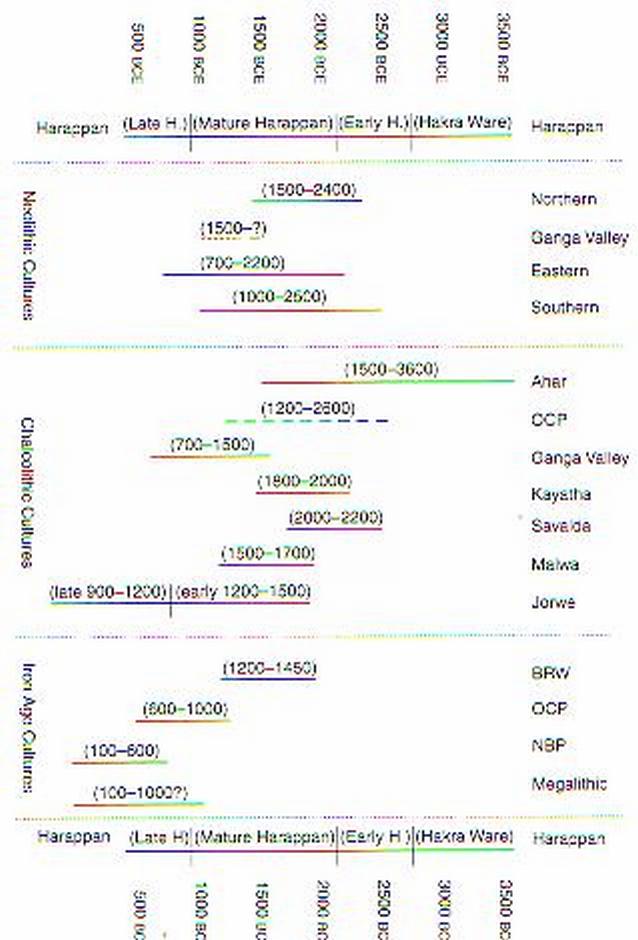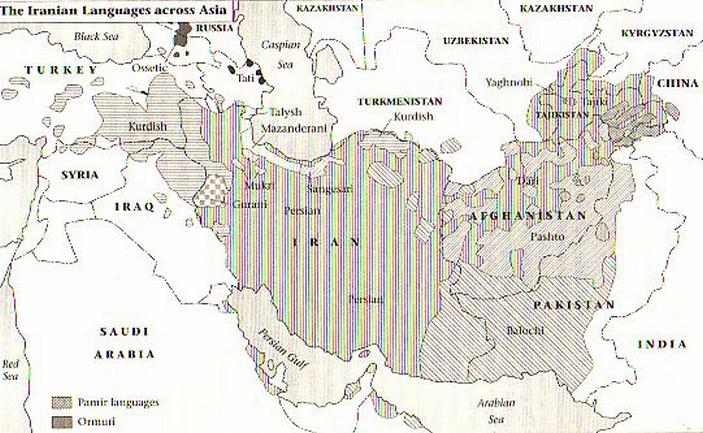Because language
contact and geographical displacement imply various kinds of social change, it
is inferred that the contact between "Indus" language and the Munda/Para-Munda
languages was somewhat intense, implying a fairly high
degree of socioeconomic integration. The same was true later, of the contact
between OIA (presumably both the inner and outer varieties) and the local
languages, which presumably included both "Indus" and Para-Munda. In
both cases, if "Indus" and Para-Munda were languages of the
Indus Valley culture (respectively a local language and an interregional lingua
franca), then it would not be surprising if such contact occurred; nor would it
be surprising if early speakers of Indo-Persian interacted with the local
people in similar ways, given the need of pastoralists for agricultural
produce. Interactions between Dravidian and Indo-Persian speakers appear to be
somewhat later, and perhaps occurred first in a place
called ‘Sindh’.
In fact
Dravidian languages were present probably by 1000 BCE if not earlier. And
Dravidian place name suffixes are found in Maharashtra, Gujarat, and Sindh, and
Dravidian may have played a role in the southern cities of the Indus Valley
culture in Sindh and Gujarat. Outer Indo-Persian languages probably appeared in
this area by the mid-second millennium BCE or earlier.
Following are early languages in contact with each other
in various parts of the subcontinent:

The Prakrits provide some suggestions of regional dialect variation
but by end 2004, we have no knowledge of the
relationship between the literary tradition that has been handed, and the
actual usage of the majority of Indo-Persian speakers. Evidence
suggests that regional variation was probably greater, even from the
earliest times, than one can infer from any analysis of the traditional texts.
The Nuristani or Kafiri languages, a separate branch
of the Indo-Iranian languages, may have found their way to their current
locations a few centuries earlier. Korku, a North Munda language listed above,
is spoken in Nimar District of Madhya Pradesh. And Speakers of outer IA may
also have entered the Kosala/Avadh area from the Narmada across the Vindhya
complex, via the valleys of the Son and other rivers.
But for all its ups
and downs, today (January 2005), Persian
is still spoken beyond the borders of Iran in the northern half of Afghanistan
(as Dari, `courtly'), and beyond that in Tajikistan (as Tajik), famed for
its poetry.

Next as we will see particularly the attractions of the Buddha's
teachings caused the spread of Sanskrit in its path northward,
round the Himalayas to Tibet, China, Korea and Japan (for all we know,
Buddha lived in the fifth century BC, in the lower valley of the Ganges,
speaking a Prakrit known as Magadhi). The faith he founded spread all over
India and §ri Lanka, as well as into Burma, its
scriptures largely written in a closely related Prakrit, Pali, but also, more
and more over time, in classical Sanskrit. Besides the spread to South-East
Asia, the most influential path that Buddhism took was to Kashmir, and back to
the homeland of Sanskrit itself in Panjab and Swat.
Hence in the first
century AD Buddhism, with its attendant scriptures, spread northward, perhaps
here again trekking back up the historic route that Sanskrit speakers had used
to enter India over a millennium before. But past Bactria, instead of turning left
into the central Asian steppes, it turned right and, picking up the Silk Road,
headed into China. Received by the rising Tang dynasty, and ultimately
propagated by them, Buddhism became coextensive with Chinese culture. Thence it
was ultimately transmitted, along with its Sanskrit and Pali scriptures, to
Korea and Japan, its most easterly homes, arriving at the end of the sixth
century.
Other, closer, areas
took much longer to receive the doctrine, borne as ever by its vehicles Pali
and Sanskrit. Nepal had been part of the early Indian spread of Buddhism under
Asoka, in the third century BC; but the first Indian monk invited into Tibet, Sdntaraksita, came in the second half of the eighth
Sanskrit, then, has a far-flung history, and has been in contact with cultures
conducted in other languages all over southern, eastern and central Asia. And
interesting generalisation emerges. Nowhere has this
linguistic contact led t loss or replacement of other
linguistic traditions, even though Sanskrit has always been central to new
cultural developments wherever it has reached. This record makes a striking
contrast with the impact, too often devastating, of languages of large-scale campaigning
civilizations, such as Greek, Latin, Arabic, Spanish, French and English (for
the latter see part 3 below).
In 1979 Victor Sariyiannidis a Greek Archeologist, discovered 20,000
pieces of gold jewelry in Tilia Tepe (Bactriana)
in Afghanistan, and proceed next to investigate what he said was the home of
Zoroastrianism. In 2000 BC, tribes from different parts of the ancient world,
particularly from northern Syria, were forced to leave their land because of a
major drought that affected some parts of the world. They arrived at what was
then the fertile delta of the Amu Daria River in southeastern Turkmenistan and
settled there.
On the banks of this river they built their capital, Gonur, whose
palace had an entrance similar to that at Knossos, reported Sariyiannidis. Claimed to be the cradle of
Zoroastrianism, a the temple of water was built on this lakeshore.
A grant by the Greek state in 1996 Greek allowed
students to join in the effort, “but none ever arrived,” said Sariyiannidis returning back to Greece late
2004.
The origin of
Sumerian is obscure; only some Georgians claim that their language is related,9
but the claim has not been widely accepted. Whatever their previous history,
there was evidently a lively set of communities active in southern Mesopotamia
from the fourth millennium Bc, absorbing the gains
from the then recent institutionalisation of
agriculture, and establishing the first cities. (See part 4 below)
Thus part of Mesopotamia, had in
fact already been dead for another 1300 years when those documents from
Sennacherib's library were written. But it turned out that the only way to
understand Akkadian cuneiform writing was to see it as an attempt to
reinterpret a sign system that had been designed for Sumerian use. The
intricacy, and probably the prestige, of the early Sumerian writing had been
such that any outsiders who wanted to adopt it for their own language had
largely had to take the Sumerian language with it.
This was not too big
a problem in cases where signs had a clear meaning: signs that stood for
Sumerian words were just given new pronunciations, and
read as the corresponding words in Akkadian. But Akkadian was a very different
language from Sumerian, both in phonetics and in the structure of its words.
Since no new signs were introduced for Akkadian, these differences largely had
to be ignored: in effect, Akkadian speakers resigned themselves to writing
their Akkadian as it might be produced by someone with a heavy Sumerian accent.
Sumerian signs that were read phonetically went on being read as they were in Sumerian, but put
together to approximate Akkadian words; and where Akkadian had sounds that were
not used in Sumerian, they simply made do with whatever was closest.
So Sumerian survived its death as a living language in
at least two ways. It lived on as a classical language, its great literary
works canonised and quoted by every succeeding
generation of cuneiform scribes. But it also lived on as an imposed constraint
on the _expression of Akkadian, and indeed any subsequent language that aspired
to use the full cuneiform system of writing, as Elamite, Hurrian, Luwian,
Hittite and Urartian were to do, over the next two millennia. It is as if
modern western European languages were condemned to be written as closely as
possible to Latin, with a smattering of phonetic annotations to show how the time-honoured Roman spellings should be pronounced to give
a meaningful utterance in Dutch, Irish, French or English.
By 260 Bc Persians and Indo-Greeks
(first led by Diodotus) in Bactria, had declared themselves independent. At
just about the same time (and possibly caused by this rebellion) the
Iranian-speaking Parthians thrust south from the eastern shores of the Caspian
into the plateau of Iran. A century later, in 146 BC, Mithradata
I of Parthia completed the job, and drove the Seleucids out of the rest of
Iran, taking Mesopotamia for good measure. Ten years later, as it happened, the
Indo-Greek kings of Bactria were overwhelmed by a Scythian (Saka) invasion from
the north, shortly followed by the Kushdna (also
known as Tocharians or Yuezhi) from the north-east.
In 1979 Victor Sariyiannidis a Greek Archeologist, discovered
20,000 pieces of gold jewelry in Tilia Tepe (Bactriana)
in Afghanistan, and proceed next to investigate what he said was the home of
Zoroastrianism. In 2000 BC, tribes from different parts of the ancient world,
particularly from northern Syria, were forced to leave their land because of a
major drought that affected some parts of the world. They arrived at what was
then the fertile delta of the Amu Daria River in southeastern Turkmenistan and
settled there.
On the banks of this river they built their capital, Gonur, whose
palace had an entrance similar to that at Knossos, reported Sariyiannidis. Claimed to be the cradle of
Zoroastrianism, a the temple of water was built on this lakeshore.
A grant by the Greek state in 1996 Greek allowed
students to join in the effort, “but none ever arrived,” said Sariyiannidis returning back to Greece late
2004.
Finally the advent of the Romans in the west, and the
Parthians in the east, in the middle of the second century BC, meant that Greek
was challenged. It responded in different ways. To Latin, it yielded legal and
military uses, but very little else, so that Syria, Palestine and Egypt found
themselves now areas where three languages or more were in contention. But
before Parthian, which was a close relative of Persian (and whose speakers
shared allegiance to the Zoroastrian scriptures, the Avesta), Greek was
effectively eliminated, while Aramaic had something of a resurgence at least as
a written language. Its use went on to inspire all but one of the writing
systems henceforth used for the Iranian languages, Parthian and Persian
(Pahlavi) in the west, Khwarezmian, Sogdian and the
Scythian languages Saka and Ossetic in the east, as well as for the Avesta
scriptures themselves. The one exception is Bactrian, later to become the
language of the Kushana empire (first to second centuries AD), written in the
Greek alphabet. This shows the lasting cultural influence of
apparently independent Greek dynasties in the far east, whom
the Kushâna supplanted.
Aramaic was by now an
official language nowhere, and a majority-community language only in the
Fertile Crescent. Nevertheless, it remained the predominant language over this
large area for almost a thousand years until the seventh century AD, when a
completely new language overwhelmed it.
This was Arabic,
brought with Islamic inspiration and a fervent will by the early converts of
the prophet Muhammad.
Sanskrit and Ancient Culture in Asia
The Spread of English in Asia plus the Rest of
the World
For updates
click homepage here